DODGE SPRINTER 2006 1.G Owners Manual
Manufacturer: DODGE, Model Year: 2006, Model line: SPRINTER, Model: DODGE SPRINTER 2006 1.GPages: 330, PDF Size: 10.82 MB
Page 181 of 330
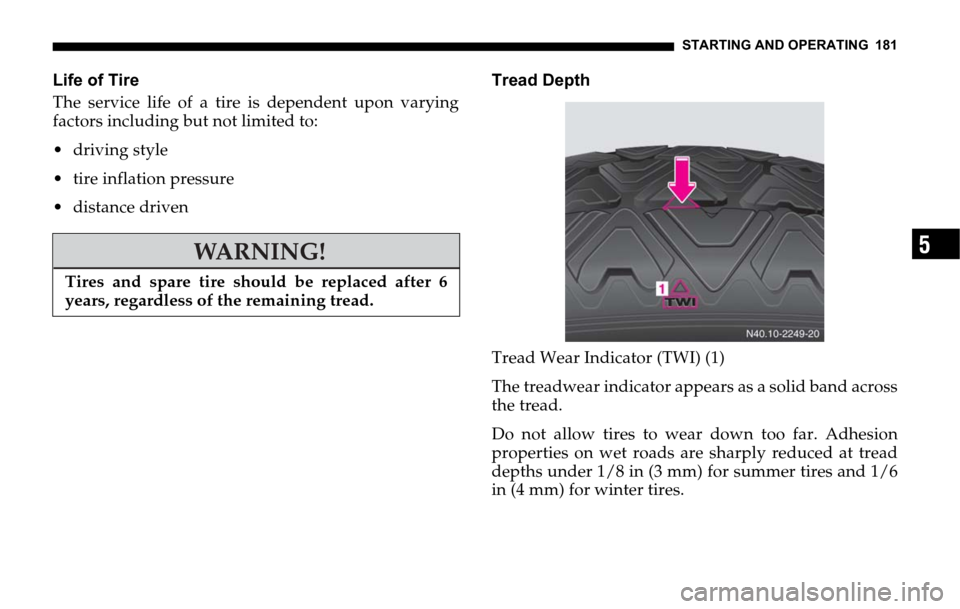
STARTING AND OPERATING 181
5
Life of Tire
The service life of a tire is dependent upon varying
factors including but not limited to:
driving style
tire inflation pressure
distance drivenTread Depth
Tread Wear Indicator (TWI) (1)
The treadwear indicator appears as a solid band across
the tread.
Do not allow tires to wear down too far. Adhesion
properties on wet roads are sharply reduced at tread
depths under 1/8 in (3 mm) for summer tires and 1/6
in (4 mm) for winter tires.
WARNING!
Tires and spare tire should be replaced after 6
years, regardless of the remaining tread.
Page 182 of 330
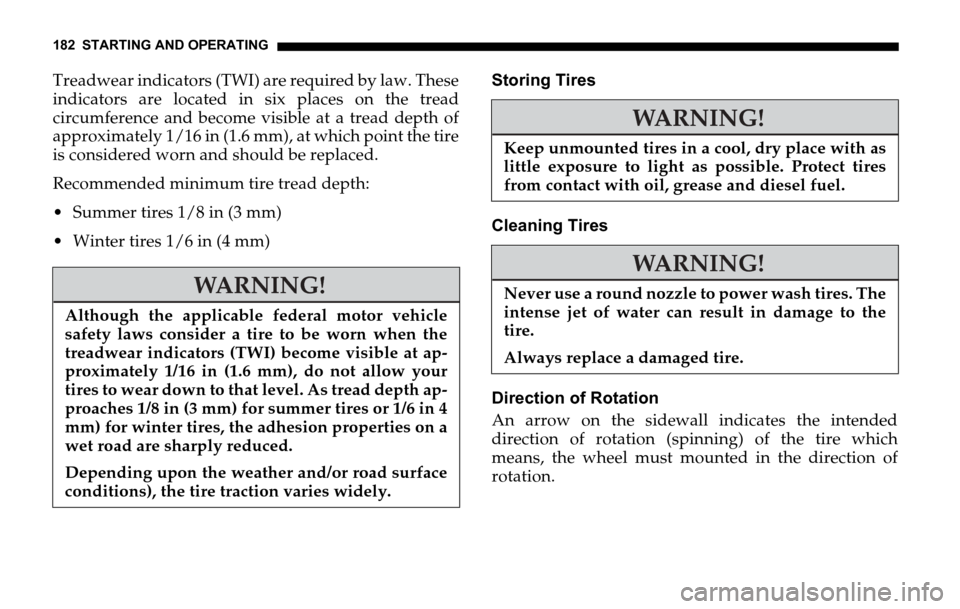
182 STARTING AND OPERATING
Treadwear indicators (TWI) are required by law. These
indicators are located in six places on the tread
circumference and become visible at a tread depth of
approximately 1/16 in (1.6 mm), at which point the tire
is considered worn and should be replaced.
Recommended minimum tire tread depth:
Summer tires 1/8 in (3 mm)
Winter tires 1/6 in (4 mm)Storing Tires
Cleaning Tires
Direction of Rotation
An arrow on the sidewall indicates the intended
direction of rotation (spinning) of the tire which
means, the wheel must mounted in the direction of
rotation.
WARNING!
Although the applicable federal motor vehicle
safety laws consider a tire to be worn when the
treadwear indicators (TWI) become visible at ap-
proximately 1/16 in (1.6 mm), do not allow your
tires to wear down to that level. As tread depth ap-
proaches 1/8 in (3 mm) for summer tires or 1/6 in 4
mm) for winter tires, the adhesion properties on a
wet road are sharply reduced.
Depending upon the weather and/or road surface
conditions), the tire traction varies widely.
WARNING!
Keep unmounted tires in a cool, dry place with as
little exposure to light as possible. Protect tires
from contact with oil, grease and diesel fuel.
WARNING!
Never use a round nozzle to power wash tires. The
intense jet of water can result in damage to the
tire.
Always replace a damaged tire.
Page 183 of 330
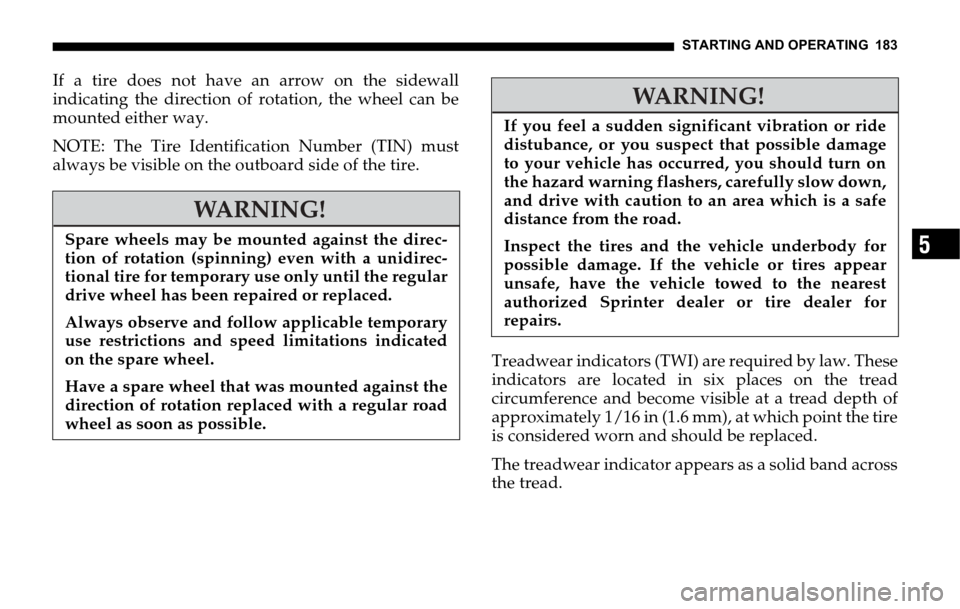
STARTING AND OPERATING 183
5
If a tire does not have an arrow on the sidewall
indicating the direction of rotation, the wheel can be
mounted either way.
NOTE: The Tire Identification Number (TIN) must
always be visible on the outboard side of the tire.
Treadwear indicators (TWI) are required by law. These
indicators are located in six places on the tread
circumference and become visible at a tread depth of
approximately 1/16 in (1.6 mm), at which point the tire
is considered worn and should be replaced.
The treadwear indicator appears as a solid band across
the tread.
WARNING!
Spare wheels may be mounted against the direc-
tion of rotation (spinning) even with a unidirec-
tional tire for temporary use only until the regular
drive wheel has been repaired or replaced.
Always observe and follow applicable temporary
use restrictions and speed limitations indicated
on the spare wheel.
Have a spare wheel that was mounted against the
direction of rotation replaced with a regular road
wheel as soon as possible.
WARNING!
If you feel a sudden significant vibration or ride
distubance, or you suspect that possible damage
to your vehicle has occurred, you should turn on
the hazard warning flashers, carefully slow down,
and drive with caution to an area which is a safe
distance from the road.
Inspect the tires and the vehicle underbody for
possible damage. If the vehicle or tires appear
unsafe, have the vehicle towed to the nearest
authorized Sprinter dealer or tire dealer for
repairs.
Page 184 of 330
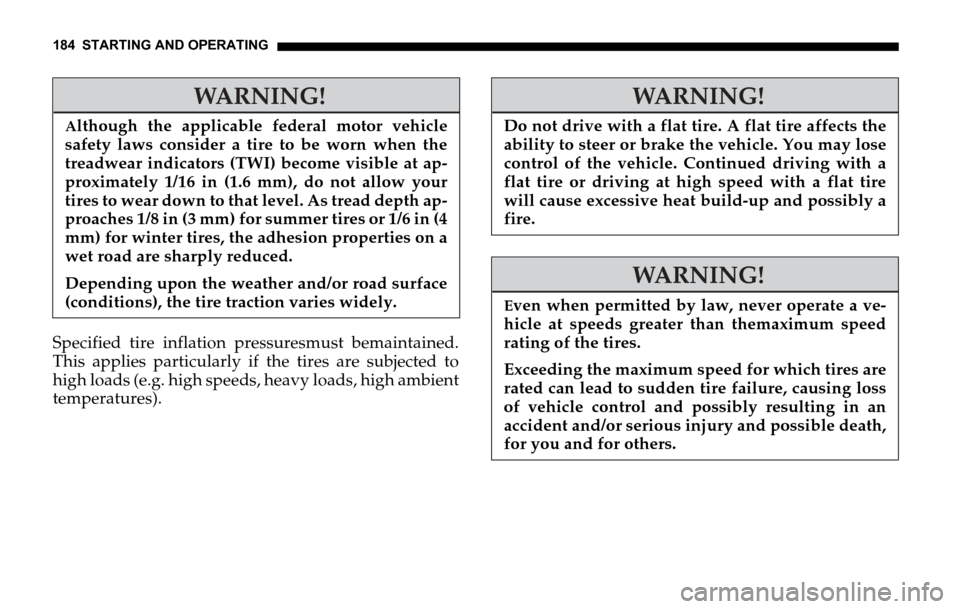
184 STARTING AND OPERATING
Specified tire inflation pressuresmust bemaintained.
This applies particularly if the tires are subjected to
high loads (e.g. high speeds, heavy loads, high ambient
temperatures).
WARNING!
Although the applicable federal motor vehicle
safety laws consider a tire to be worn when the
treadwear indicators (TWI) become visible at ap-
proximately 1/16 in (1.6 mm), do not allow your
tires to wear down to that level. As tread depth ap-
proaches 1/8 in (3 mm) for summer tires or 1/6 in (4
mm) for winter tires, the adhesion properties on a
wet road are sharply reduced.
Depending upon the weather and/or road surface
(conditions), the tire traction varies widely.
WARNING!
Do not drive with a flat tire. A flat tire affects the
ability to steer or brake the vehicle. You may lose
control of the vehicle. Continued driving with a
flat tire or driving at high speed with a flat tire
will cause excessive heat build-up and possibly a
fire.
WARNING!
Even when permitted by law, never operate a ve-
hicle at speeds greater than themaximum speed
rating of the tires.
Exceeding the maximum speed for which tires are
rated can lead to sudden tire failure, causing loss
of vehicle control and possibly resulting in an
accident and/or serious injury and possible death,
for you and for others.
Page 185 of 330

STARTING AND OPERATING 185
5
Vehicles type 2500 C/HC/SHC
The vehicles are factory equipped with "L" or "N"-rated
tires, which have a speed rating of 74 mph (120 km/h)
or 87 mph (140 km/h) respectively.
Vehicles type 3500 C/HC/SHC
The vehicles are factory equipped with "L", "N" or "R"-
rated tires, which have a speed rating of 74 mph (120
km/h), 87 mph (140 km/h) or 106 mph (170 km/h)
respectively.
Tire Grip
Tire grip is greatly reduced on a wet, snow covered or
icy road. Speed and driving style must therefore be
adapted to suit road conditions. The safe speed on a
wet, snow covered or icy road is always lower than on
a dry road.
Below a tread depth of 1/8 in (3 mm), tire grip begins
to decrease rapidly on wet roads.
Pay particular attention to the condition of the road
whenever the outside temperatures are close to the
freezing point.Hydroplaning
Depending on the depth of the water layer on the road,
hydroplaning may occur, even at low speeds and with
new tires. Reduce vehicle speed, avoid track grooves in
the road, and apply brakes cautiously in the rain.
In winter, install M+S radial tires with a minimum
tread depth of approximately 1/6 in (4 mm) on all
wheels to ensure normal balanced handling
characteristics. On packed snow, they can reduce your
stopping distance compared to summer tires.
Stopping distance, however, is still considerably
greater than when the road is not covered with snow or
ice. Exercise appropriate caution.
For information on winter tires, refer to "Winter
Operation".
WARNING!
If ice has formed on the road, tire traction will be
substantially reduced. Under such weather condi-
tions, drive, steer and brake with extreme caution.
Page 186 of 330

186 STARTING AND OPERATING
Recommended Tire Inflation Pressure
The tire inflation pressure (including the spare wheel)
should be checked regularly and adjusted as well asinspecting for signs of tire wear or visible damage. Use
a good quality pocket-type gauge to check tire inflation
pressure.
Do not make a visual judgement when determining
proper inflation. Radial tires may look properly
inflated even when they are underinflated.
The tire inflation pressure should be checked
regularly, i.e. at least each time you refuel the vehicle,
and should only be adjusted on cold tires. The
preferred interval for checking the tire inflation
pressure, however, is before each trip.
The tires can be considered cold if the vehicle has been
parked for at least 3 hours or driven less than 1 mile
(1.6 km) at an ambient temperature of approximately
68 °F (20 °C).
Follow recommended cold tire inflation pressures
listed on Tire and Loading Information placard on the
driver’s door B-pillar.
Keeping the tires properly inflated provides the best
handling, tread life and riding comfort.
The pressure difference between the tires on a single
axle should not exceed 1.5 psi (10 kPa).
WARNING!
Avoid spinning of one drive wheel. This may
cause serious damage to the drivetrain which is
not covered by the Warranty.
WARNING!
Follow recommended tire inflation pressures.
Do not underinflate tires. Underinflated tires
wear excessively and/or unevenly, adversely
affect handling and fuel economy, and are more
likely to fail from being overheated.
Do not overinflate tires. Overinflated tires can
adversely affect handling and ride comfort, wear
unevenly, increase stopping distance, and result
in sudden deflation (blowout) because they are
more likely to become punctured or damaged by
road debris, potholes etc.
Page 187 of 330
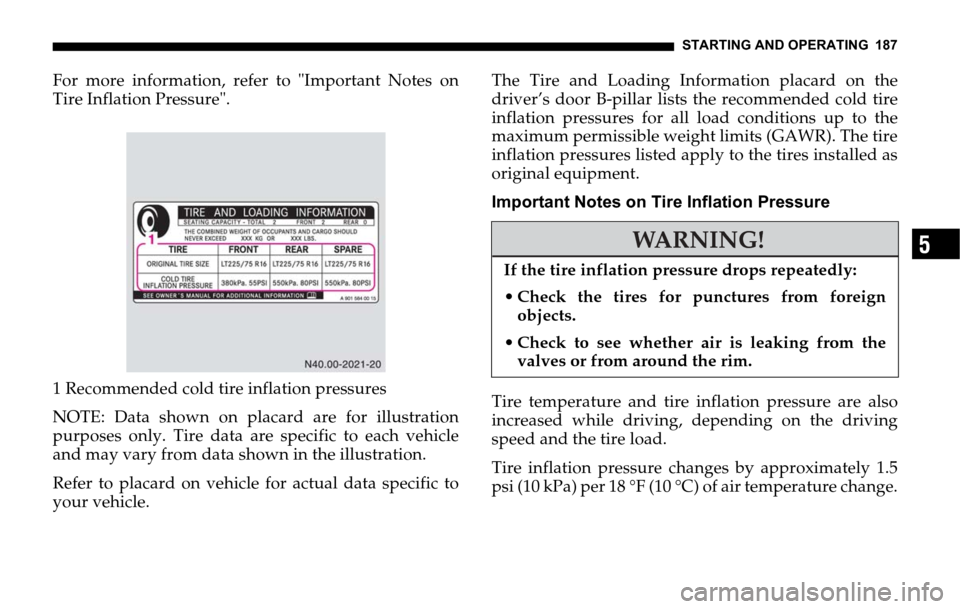
STARTING AND OPERATING 187
5
For more information, refer to "Important Notes on
Tire Inflation Pressure".
1 Recommended cold tire inflation pressures
NOTE: Data shown on placard are for illustration
purposes only. Tire data are specific to each vehicle
and may vary from data shown in the illustration.
Refer to placard on vehicle for actual data specific to
your vehicle.The Tire and Loading Information placard on the
driver’s door B-pillar lists the recommended cold tire
inflation pressures for all load conditions up to the
maximum permissible weight limits (GAWR). The tire
inflation pressures listed apply to the tires installed as
original equipment.
Important Notes on Tire Inflation Pressure
Tire temperature and tire inflation pressure are also
increased while driving, depending on the driving
speed and the tire load.
Tire inflation pressure changes by approximately 1.5
psi (10 kPa) per 18 °F (10 °C) of air temperature change.
WARNING!
If the tire inflation pressure drops repeatedly:
Check the tires for punctures from foreign
objects.
Check to see whether air is leaking from the
valves or from around the rim.
Page 188 of 330

188 STARTING AND OPERATING
Keep this in mind when checking tire inflation
pressure where the temperature is different from the
outside temperature.
For example:
If inside temperature is 68 °F (20 °C) and the outside
temperature is 32 °F (0 °C) then the cold tire inflation
pressure should be increased by 3 psi (0.2 bar), which
equals 1.5 psi (0.1 bar) for every 18 °F (10 °C) for this
outside temperature condition.
Check tire pressures more often if subject to a wide
range of outdoor temperatures, as tire pressures vary
with temperature changes.Checking Tire Inflation Pressure
The tire inflation pressure should be checked
regularly, i.e. at least each time you refuel the vehicle.
The preferred interval for checking the tire inflation
pressure, however, is before each trip.
Inflation pressures specified on the Tire and Loading
Information placard on the driver’s door B-pillar are
always cold tire inflation pressures. Check and adjust
the tire inflation pressure when the tires are cold. Cold
tire inflation pressure is defined as the tire pressure
after the vehicle has been parked for at least 3 hours or
driven less than 1 mile (1.6 km) at an ambient
temperature of approximately 68 °F (20 °C).
The cold tire inflation pressure must not exceed the
maximum tire inflation pressure molded into the tire
side wall, refer to "Tire Labeling".
If you check the tire inflation pressure when the tires
are warm (the vehicle has been driven for several miles
or sitting less than 3 hours), the reading will be higher
than the cold reading. This is normal. Do not let air out
to match the specified cold tire inflation pressure.
Otherwise, the tire will be underinflated.
WARNING!
Tire pressure may increase during operation.
Never reduce this normal pressure build up or
your tire pressure will be too low.
Underinflated tires wear excessively and/or
unevenly, adversely affect handling and fuel
economy, and are more likely to fail from being
overheated.
Page 189 of 330
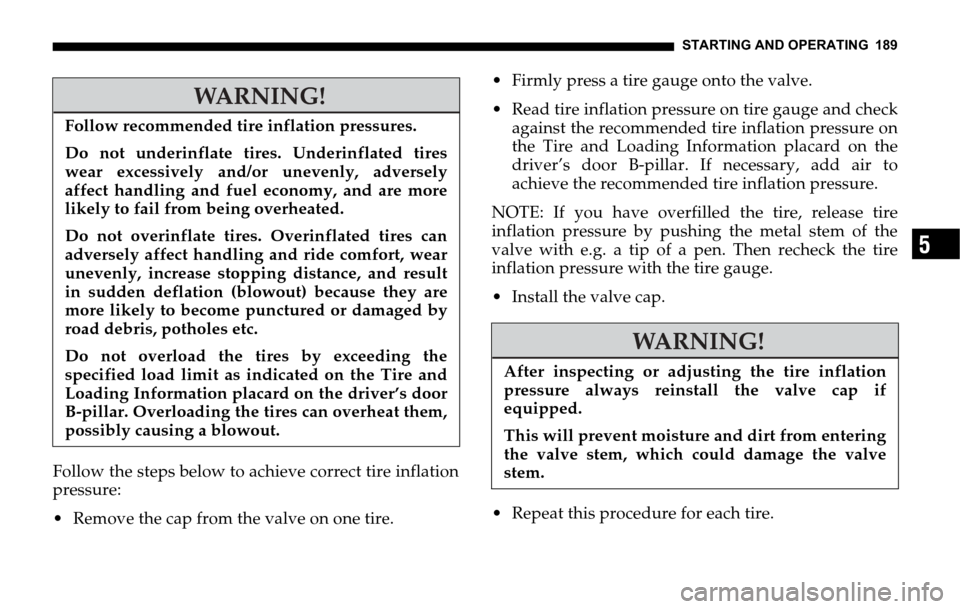
STARTING AND OPERATING 189
5
Follow the steps below to achieve correct tire inflation
pressure:
Remove the cap from the valve on one tire. Firmly press a tire gauge onto the valve.
Read tire inflation pressure on tire gauge and check
against the recommended tire inflation pressure on
the Tire and Loading Information placard on the
driver’s door B-pillar. If necessary, add air to
achieve the recommended tire inflation pressure.
NOTE: If you have overfilled the tire, release tire
inflation pressure by pushing the metal stem of the
valve with e.g. a tip of a pen. Then recheck the tire
inflation pressure with the tire gauge.
Install the valve cap.
Repeat this procedure for each tire.
WARNING!
Follow recommended tire inflation pressures.
Do not underinflate tires. Underinflated tires
wear excessively and/or unevenly, adversely
affect handling and fuel economy, and are more
likely to fail from being overheated.
Do not overinflate tires. Overinflated tires can
adversely affect handling and ride comfort, wear
unevenly, increase stopping distance, and result
in sudden deflation (blowout) because they are
more likely to become punctured or damaged by
road debris, potholes etc.
Do not overload the tires by exceeding the
specified load limit as indicated on the Tire and
Loading Information placard on the driver’s door
B-pillar. Overloading the tires can overheat them,
possibly causing a blowout.
WARNING!
After inspecting or adjusting the tire inflation
pressure always reinstall the valve cap if
equipped.
This will prevent moisture and dirt from entering
the valve stem, which could damage the valve
stem.
Page 190 of 330

190 STARTING AND OPERATING
Potential Problems associated with Underinflated
and Overinflated Tires
Proper tire inflation pressure is essential to the safe and
satisfactory operation of your vehicle. Three primary
areas are affected by improper tire inflation pressure:
1. Safety
WARNING!
Improperly inflated tires are dangerous and can
cause accidents.
Underinflation increases tire flexing and can
result in tire failure.
Overinflation reduces a tire’s ability to
cushionshock. Objects on the road and chuck
holes can cause damage that results in tire
failure.
Unequal tire inflation pressures can cause
steering problems.You could lose control of
your vehicle.
Overinflated or underinflated tires can
affectvehicle handling and can fail suddenly,
resulting in loss of vehicle control.
Unequal tire pressures from one side of the
vehicle to the other can cause the vehicle to drift
to the right or left. Always drive with each tire
inflated to the recommended cold tire inflation
pressure.